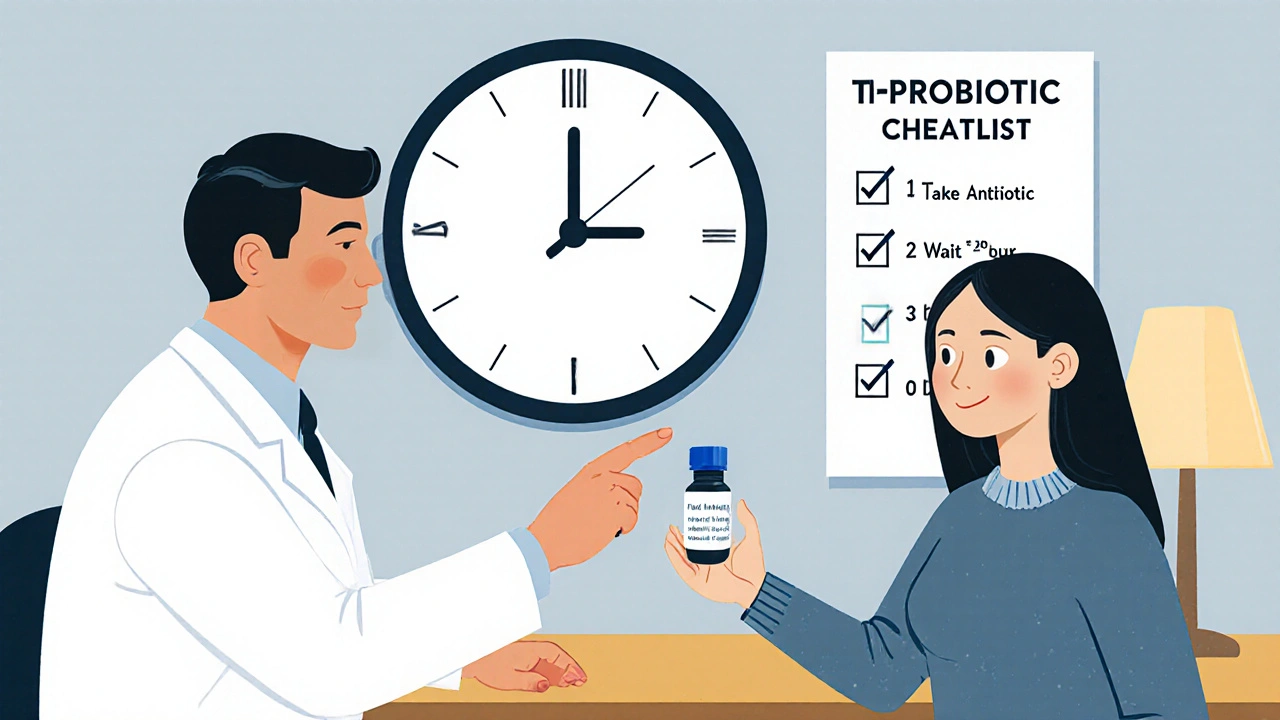Probiotic-Antibiotic Timing Calculator
How This Calculator Works
Research shows probiotics need to be taken at least 2-3 hours away from antibiotics to be effective. This calculator helps you determine the optimal timing based on your antibiotic schedule.
Key Recommendation: Take probiotics at least 2-3 hours after each antibiotic dose to avoid direct killing by the antibiotic.
Enter Your Antibiotic Schedule
Add your antibiotic doses below to calculate probiotic timing.
Quick Takeaways
- Take probiotics at least 2‑3 hours apart from antibiotics to avoid direct killing.
- Best‑studied strains for antibiotic‑associated diarrhea are Lactobacillus rhamnosus GG and Saccharomyces boulardii.
- Continue the probiotic for 1-2 weeks after the last antibiotic dose; longer for broad‑spectrum courses.
- Typical dose: 5-40 billion CFU daily; higher doses for immunocompromised patients under medical supervision.
- Watch for temporary gas or bloating-usually harmless and subsides within a few days.
Antibiotics save lives, but they also wipe out the good bacteria living in your gut. That collateral damage can trigger nausea, cramping, and the dreaded antibiotic‑associated diarrhea (AAD). Over the past few years, researchers have zeroed in on whether probiotics live microorganisms that, when taken in adequate amounts, confer a health benefit can blunt those side effects - and more importantly, when you should take them.
How Antibiotics Disrupt the Gut Microbiome
When you pop a pill of amoxicillin or ciprofloxacin, the drug circulates through your bloodstream and reaches the gastrointestinal tract. It isn’t selective; it kills both pathogenic and beneficial microbes. Studies published by the Microbiology Society a UK‑based scientific organization that publishes microbiology research in 2022 showed that a typical 7‑day course can reduce microbial diversity for up to two years in some people.
The loss of diversity weakens colonisation resistance, allowing opportunistic organisms like Clostridioides difficile to thrive. It also alters the pool of metabolic by‑products, which can affect mood, immunity, and even weight regulation.
What Probiotics Actually Do
Probiotics introduce live strains back into the gut, aiming to preserve or restore diversity while the antibiotic does its job. The 2024 double‑blind study by D. John et al. in Frontiers in Microbiomes reported that daily probiotic supplementation during antibiotic therapy lowered the abundance of antibiotic‑resistance genes (ARGs) compared with placebo - a potential public‑health win.
However, not every probiotic is created equal. The protective effect hinges on strain specificity, dosage, and timing. Two strains consistently rise to the top:
- Lactobacillus rhamnosus GG a well‑studied lactic‑acid bacterium shown to reduce AAD risk
- Saccharomyces boulardii a non‑pathogenic yeast that survives antibiotics and combats diarrhea
Timing Strategies - What the Evidence Says
Researchers agree on one core principle: keep the probiotic away from the antibiotic’s peak concentration. Direct contact can kill the probiotic before it even reaches the colon.
Harvard Medical School’s clinical guidance (Nov 2023) recommends a 2‑ to 3‑hour gap. In practice, that looks like:
- Take your antibiotic dose (e.g., 8 am).
- Wait at least two hours.
- Take the probiotic (e.g., 10 am).
- Repeat the same schedule for each antibiotic dose.
Alternative schedules-such as taking the probiotic the night before or a few hours after the last daily antibiotic dose-have also shown benefit in user surveys, but the 2‑hour rule remains the most evidence‑backed.

Practical Protocol for Most Adults
Below is a step‑by‑step plan you can adapt:
- Choose a clinically backed strain: Lactobacillus rhamnosus GG or Saccharomyces boulardii.
- Check viability: Refrigerated products keep 85‑90 % of CFUs alive after 30 days; shelf‑stable options drop to 65‑70 %.
- Dosage: 5-40 billion CFU per day. For immunocompromised patients, aim for the higher end only under doctor supervision.
- Timing: Space the probiotic at least 2 hours from each antibiotic dose.
- Duration: Continue throughout the antibiotic course and for 1-2 weeks after the final pill. For broad‑spectrum agents (e.g., clindamycin), extend to 4 weeks.
The American Gastroenterological Association’s 2023 guidance mirrors these steps, emphasizing the post‑treatment extension to help the microbiome rebound.
Risks, Contra‑Indications, and Management
Probiotics are generally safe, but they’re not risk‑free. A 2022 PMC article highlighted rare systemic infections in severely immunosuppressed patients. If you have a compromised immune system, discuss strain choice and dosage with your clinician.
Temporary gas, bloating, or mild “probiotic‑associated diarrhea” can occur in 15‑20 % of users, according to the Cleveland Clinic. Most people find the symptoms subside after a few days; reducing the dose or switching to a different strain often helps.
User Experiences - What Real People Report
Reddit’s r/Probiotics community (Oct 2023) logged 1,450 anecdotes: 62 % said the probiotic reduced GI upset, while 10 % felt worse. The most common timing strategy among respondents was taking the probiotic 2 hours after the antibiotic (42 %). A Healthline survey of 2,300 antibiotic users showed a 54 % lower incidence of side effects for probiotic takers versus 31 % in the control group.
These crowdsourced data align with the clinical picture: probiotics help many, but outcomes vary by strain, timing, and individual gut composition.

Emerging Research and Future Directions
Two breakthroughs in 2024-2025 are reshaping the conversation:
- The John et al. study demonstrated a lasting drop in ARGs, hinting at antimicrobial‑resistance mitigation beyond symptom relief.
- A January 2025 Nature paper by KVA Johnson et al. linked probiotic use to improved mood after two weeks, suggesting gut‑brain axis benefits during recovery.
The International Scientific Association for Probiotics and Prebiotics (ISAPP) has pledged $4.2 million to standardise timing protocols, aiming for clearer guidelines by 2027.
Given the mixed results in systematic reviews (e.g., Łukasik 2024), expect future recommendations to be more strain‑specific and to incorporate personalized microbiome profiling.
Bottom Line: How to Use Probiotics With Antibiotics Today
Until the next consensus guideline lands, follow this pragmatic rule‑of‑thumb:
- Pick a proven strain (L. rhamnosus GG or S. boulardii).
- Take the probiotic at least 2 hours after each antibiotic dose.
- Stick with the probiotic for the full antibiotic course plus 1-2 weeks.
- Watch for gas, bloating, or rare infections; stop and seek medical advice if severe.
Doing so maximises the chance of dodging diarrhea, reduces ARG load, and gives your gut a smoother path back to balance.
Frequently Asked Questions
Can I take probiotics at the same time as my antibiotic?
It’s safest to separate them by at least two hours. This prevents the antibiotic from killing the probiotic before it reaches your gut.
Which probiotic strains work best for preventing antibiotic‑associated diarrhea?
Lactobacillus rhamnosus GG and Saccharomyces boulardii have the strongest evidence, especially when taken throughout the antibiotic course.
How long should I keep taking probiotics after finishing antibiotics?
Most clinicians advise 1-2 weeks post‑treatment; for broad‑spectrum antibiotics, extending to four weeks can aid full microbial recovery.
Are there any risks for healthy adults?
Side effects are usually mild - gas, bloating, or temporary soft stools. Serious infections are rare and mainly affect immunocompromised individuals.
Do I need to refrigerate my probiotic?
Refrigerated strains stay more viable (85‑90 % after 30 days). Shelf‑stable products are convenient but may lose potency faster.
Comparison of Common Timing Approaches
| Timing Method | Typical Gap | Impact on AAD | Effect on Microbiome Recovery |
|---|---|---|---|
| Concurrent (same dose) | 0 h | Mixed - some studies show no benefit | Potential delay in recovery |
| Antibiotic first, probiotic 2‑3 h later | 2‑3 h | ~48 % risk reduction in AAD (meta‑analysis) | Shortest recovery time reported |
| Probiotic first, antibiotic 2‑3 h later | 2‑3 h | Similar benefit to the reverse order | Comparable recovery speed |
| Probiotic only after antibiotics | - | Reduces late‑onset diarrhea | May delay full diversity restoration (Palleja 2018) |

Bianca Larasati
October 25, 2025 AT 15:38Wow, this guide really breaks down the timing game! I’ve always been confused about when to pop the probiotic during a course of amoxicillin. Splitting them by a couple of hours makes total sense, and it’s great to see the science backing it up. I’m definitely going to set a reminder on my phone so I don’t forget. Thanks for the clear steps!
Sarah Keller
November 6, 2025 AT 05:25The evidence hierarchy presented here is compelling, especially when you consider the mechanistic underpinnings of microbial resilience.
First, the gut microbiome operates as an ecological network, and antibiotics act as a perturbation that reduces both richness and evenness.
Second, probiotic strains such as L. rhamnosus GG have been shown to re‑colonize niches that antibiotics vacate, thereby reinstating colonisation resistance.
Third, the temporal separation of 2‑3 hours is not arbitrary; pharmacokinetic studies demonstrate that peak plasma concentrations of most oral antibiotics occur within 1‑2 hours, so waiting beyond that window spares the probiotic.
Fourth, the dosage range of 5‑40 billion CFU is grounded in dose‑response curves that reveal a threshold effect for efficacy.
Fifth, extending the course post‑antibiotic mirrors the concept of ecological succession, allowing a stable community to re‑establish.
Sixth, the data on ARG reduction suggest a public‑health benefit beyond individual symptom relief.
Seventh, the safety profile in immunocompetent hosts is robust, with only mild GI side‑effects reported.
Eighth, the rare cases of systemic infection underscore the need for medical oversight in high‑risk patients.
Ninth, the comparative tables demonstrate that concurrent administration fails to improve outcomes, reinforcing the timing rule.
Tenth, user‑generated data from r/Probiotics aligns with the clinical trials, adding real‑world validity.
Eleventh, the emerging mood‑benefit research hints at gut‑brain axis modulation during recovery.
Twelfth, the upcoming ISAPP standardization will likely refine strain‑specific recommendations.
Thirteenth, personalized microbiome profiling may eventually tailor timing to individual pharmacodynamics.
Fourteenth, clinicians should incorporate this protocol into antimicrobial stewardship programs.
Fifteenth, patients should be educated about the simple 2‑hour gap to maximize benefit.
Veronica Appleton
November 17, 2025 AT 19:11For anyone looking for a quick tip, just set an alarm on your phone for the probiotic dose two hours after you take the antibiotic.
This way you won’t accidentally overlap them and you’ll keep the probiotic alive.
Also, check the label for CFU count – the higher the better within the recommended range.
Stay consistent and you’ll likely dodge the dreaded diarrhea.
the sagar
November 29, 2025 AT 08:58Don't trust any pharma lying about probiotics.
Grace Silver
December 10, 2025 AT 22:45While the aggressive tone is noted, the data still holds.
The 2‑hour gap is based on solid pharmacology.
Even if you doubt the source, the practical outcome remains beneficial.